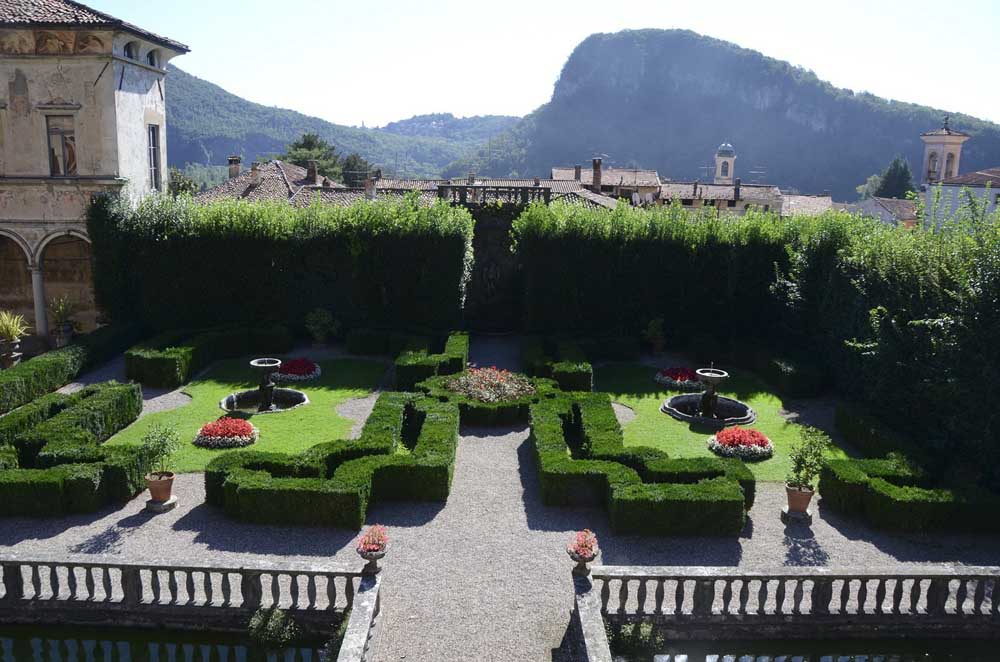Restoring historic palace motivates Italian couple
Published 12:00 am Sunday, March 1, 2015

- Doug Oster / Pittsburg Post-GazetteAn overall view of the formal garden at Villa Cicogna Mozzoni in Bisuschio, Italy. Funded by tourists and occasional weddings, Jacopo Cicogna Mozzoni and longtime partner Silvia Casarotto have dedicated their lives to restoring and maintaining the garden.
BISUSCHIO, Italy — Soft light bathes Barbara Simoneschi as she gazes out the weathered windows of Villa Cicogna Mozzoni. She’s watching our group of 32 gardeners explore the courtyard and frescoes of this historic palace, which dates to the Renaissance.
There’s something about the way she’s framed that seems reminiscent of a classic Italian painting.
Trending
Below her, we are given a guided tour by the most down-to-earth nobleman in the world. Jacopo Cicogna Mozzoni shares sweet stories about being in the gardens as a child. He laughs easily, reveals his sly wit and captivates his small audience with tales from another era.
These aren’t the most incredible gardens we saw in Italy, but hearing their personal history from someone who loves them was both heartwarming and fascinating.
The morning sun rose over the green mountains, illuminating deep red dahlias and making them shine amid beautifully pruned hedges and ancient stone walls. Water splashes from a fountain and falls playfully on the face of a stone cherub near two large reflecting pools. A mysterious pink impatiens that can’t be identified by a plant expert on the trip thrives in a small container in a corner.
Behind the villa are old greenhouses filled with replacement plants for filling holes in the garden. Exploring a back trail next to the glass houses reveals tall purple asters covered with honey bees.
When Mozzoni is joined inside by his longtime partner, Silvia Casarotto, things really get interesting. It’s obvious the two are in love, not only with each other but also with the villa itself. The affable couple are quick with good-natured barbs but also with soft kisses. Our group of travelers hang on each word as they tell stories about the place they have dedicated their lives to preserving. It’s huge, very old and needs work. When a visitor reaches up to touch a shiny orb on a banister, it almost falls off, nearly giving her a heart attack. Later we see a portrait of a countess on the same stairway, and the orb is there, too.
Mozzoni didn’t understand the significance of the villa as a child. He lived next door and grew up playing hide and seek in the garden. He enjoyed playing a trick or two on visiting groups. When he knew a tour was coming, he would head for the attic and pretend to be a ghost. In the library he got the pump organ going and pressed on the keys with both arms “to make the most horrible sound.”
Trending
“It was very, very funny,” he added with a laugh.
It wasn’t until his mid-20s that he realized his calling: to preserve the villa and gardens. Mozzoni, the last member of his family to remain close to the villa, still hopes for help from the government, but he relies mainly on tourists and the occasional wedding reception to bring in funds for the work.
His grandmother moved out of the villa during World War II and never returned, living in the guesthouse next door. During the war, the villa was home to three families of refugees.
In 1957, the formal gardens and home were opened to the public, so the ancient fresco paintings and classic architecture could be enjoyed by the masses.
“To leave it empty was useless,” Mozzoni said.
Walking back into the courtyard from the gardens, visitors are greeted by those famous fresco paintings on the walls and ceiling of a portico. They have faded with time, but artwork inside a great hall remains vivid despite its great age. Even after all this time, Casarotto says she still finds something new when she looks at the intricate paintings.
The interior offers interesting views of the garden. Classic stone containers filled with cheerful pink begonias are framed by a doorway, variegated yuccas in containers waver when seen through the old glass windows and the view from the second floor is spellbinding.
After the tour, Simoneschi serves powerful black espresso in tiny glass cups along with plump green grapes and delicate Italian pastries.
Even though the job of keeping up with the villa is endless, the couple don’t let it get to them.
“I love this place,” Mozzoni says, “and don’t worry about the money.”
Casarotto finds it hard to put into words, especially English, what this ancient home means to her. She first came here nearly a quarter of a century ago and learned the importance of the villa from Mozzoni’s mother, Eleonore. Her eyes fill with tears as she talks passionately about Eleonore’s love for Villa Cicogna Mozzoni and how she passed that passion on to her.
“She was the countess for this villa, spoke seven languages and helped me to understand to do these things,” she says.
When asked why the couple work so hard to restore the villa, she pauses and smiles. “Simply because it’s our life,” she says. “I get to live in a fantastic dream.”








